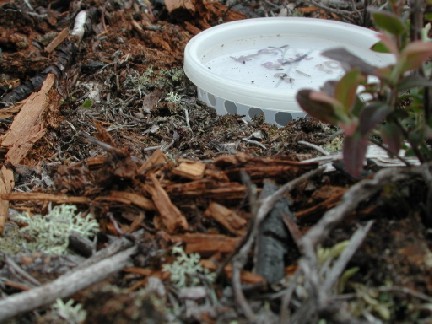
For a more complete evaluation of this
trap design, please see:
Higgins RJ, Lindgren BS. 2012. An evaluation of methods for sampling ants (Hymenoptera: Formicidae) in British Columbia,Canada. The Canadian Entomologist 144:1-17.
Pitfall traps were first described in the literature by Laurent (1917) although they are sometimes referred to as Barber traps (Barber 1931, Lemieux and Lindgren 1999). They are especially popular with entomologists working with epigaeic invertebrates because they are inexpensive, easy to install, and sample 24 hrs a day (Agosti et al. 2000).
Traditional pitfall traps (Laurent), however, have a number of drawbacks. First, they are open at the top and can capture small vertebrates, an issue for insititutional animal ethics committees following the Canadian Council on Animal Care guidelines, and may also allow larger vertebrates to directly drink the toxic trapping solution (Note: propylene glycol is preferred to ethylene glycol as a trapping solution because of its lower toxicity). Second, the open trap also allows debris to blow in, fouling trap contents and sometimes offering a ramp for invertebrates to escape. Finally, in order to prevent the trap from flooding during rainfall, raised covers and associated materials to hold the cover in place must be carried into the field. The covers can be awkward to carry into the field and they make the traps more visible to curious vertebrates (e.g., bears).
The Nordlander trap (a simple cup with snap-on lid and small opennings around the upper rim) improves or solves most of these issues. When sampling for ants, the 6 mm openings along the top rim exclude vertebrates from the trap. Examination of sampling bias for the Nordlander did not show a signficiant difference in sampling for total species richness or ant size as compared to the Laurent trap with raised cover (paper detailing this study has just been submitted for publication). Vertebrates cannot directly drink the contents of the trap and if the trap is pulled out of the ground, the solution spills into the soil. Further the snap-on lid is easy to carry into the field and with debris placed on the lid, is less visible to curious vertebrates. While some debris can blow into the trap, it is much less than that typically found in Laurent pitfalls.
The traps are easily made. The cup shown above consists of 237-ml plastic cups with snap-on lids (VWR Scientific Products, Catalogue number 44333-002). The holes are made with a simple one-hole 6 mm paper punch. If sampling for larger invertebrates the holes can be double-punched to increase their size.
All images by R. Higgins unless otherwise noted